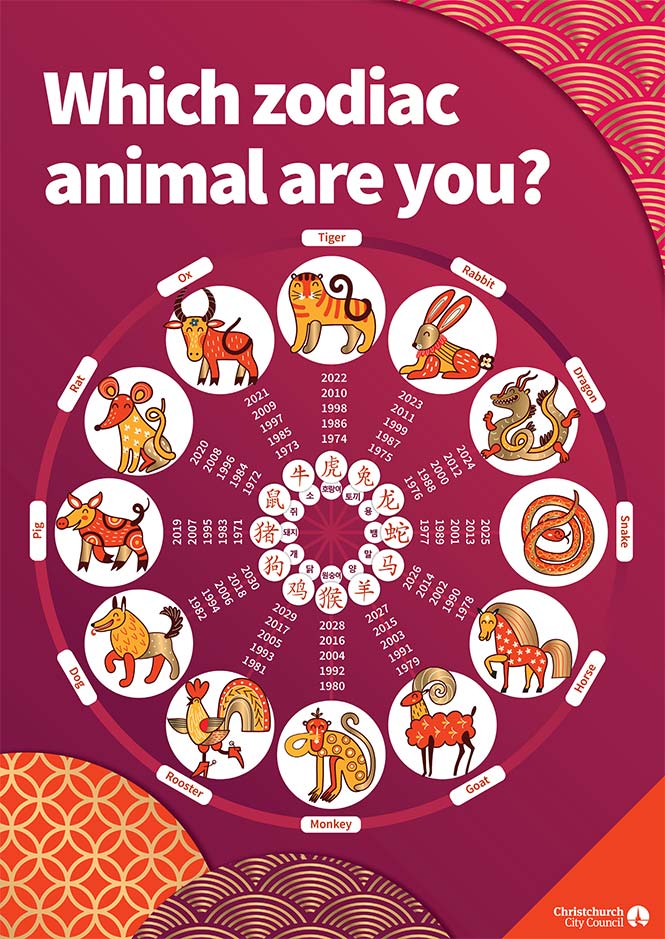Lunar New Year is a major festival in several Asian countries, such as China and Korea. With global population movements, the tradition of celebrating Lunar New Year has spread worldwide.
The 2025 Lunar New Year Day falls on 29 January. We have various events and activities happening in libraries from 1 to 15 February to celebrate this traditional festival.
The Year of the Snake (蛇年)
According to the 12-year-cycled lunar calendar, this year is the year of the snake, starting from 29 January 2025 to 16 February 2026. The year of the snake includes 2025, 2013, 2001, 1989, 1977, 1965, 1953, 1941, 1929, 1917... People born in one of these years will be in their year of fate 本命年.
According to Chinese tradition, people in their year of fate should wear red on Lunar New Year Day and even throughout the year to ward off evil spirits and maintain good luck.
The Snake in Chinese Cultural Beliefs and Practices
The snake has never been overshadowed, even though it follows the powerful dragon on the Chinese zodiac calendar. In fact, both zodiac animals are closely connected. The snake is often referred to as the "little dragon" because the mythical figure of the dragon was originally modelled after it. The snake holds a special place in Chinese cultural beliefs and practices.
Despite controversy in the Western world, the medicinal use of snakes has a long history in China and is recorded in ancient Chinese medical literature. In traditional Chinese medicine, snakes are used to treat various ailments, such as chronic skin conditions, arthritis, and whooping cough.
In Chinese culture, the snake is regarded as a spiritual animal and an important motif in mythology. For example, in an ancient painting of Fuxi and Nüwa unearthed in Xinjiang, both Fuxi, the first mythical emperor, and his sister-wife Nüwa are depicted as divine beings with serpent bodies. These figures symbolise life, reproduction, and creation.
Another well-known snake-associated figure in ancient texts is Jiuying (九嬰), a nine-headed baby. Jiuying is described as a monstrous being with nine snake-like heads and a baby’s wail, capable of spouting water and breathing fire. According to the myth, Jiuying were nine children of a god, who took turns rising into the sky to provide light and warmth. One day, they rose together, scorching the land and killing livestock, prompting Hou Yi, a divine archer, to shoot them down.
For ordinary Chinese people, snakes evoke mixed feelings due to their dual nature in myths. On one hand, the snake represents rebirth, transformation, and healing. On the other, it embodies the threats posed by nature. Despite this ambiguity, the snake is held in high regard in China. It is believed that a person’s ability to handle snakes reflects their capacity to shape their environment, as snakes symbolise the power of nature, bringing both challenges and prosperity.
The Snake's Energy in Love
The zodiac sign of the snake is generally associated with traits such as strategic thinking, intelligence, transformation, and charm. People born under the sign of the snake are believed to possess strong intuition, adaptability, and a mysterious nature, as well as being understanding and caring.
In addition to these qualities, the snake embodies another trait in one of China's most beloved folktales, The Legend of the White Snake (白蛇传). According to the story, a white snake spirit transforms herself into a beautiful young woman and meets a young man on a ferryboat in West Lake.
They fall in love and eventually marry. However, an abbot from a temple gives the man a bottle of realgar wine and convinces him to have his wife drink it. The wine reveals her true form as a snake, and the man dies of shock. Overwhelmed by love and determination, the snake woman finds a magical herb, restores her husband to life, and rescues him from the temple.
The abbot, however, tracks them down, defeats the snake woman, and imprisons her under Leifeng Pagoda in Hangzhou. Heartbroken, the man chooses to become a monk.
This touching tale of human-spirit romance is one of China's most famous folktales and was listed as a national intangible cultural heritage in 2006. It has inspired countless adaptations in various art forms, including film. The legend explores many themes in Chinese culture but most prominently highlights the snake’s bravery and passion in love.
Today, Leifeng Pagoda is a popular tourist attraction in Hangzhou. Visitors come not only to admire its architectural beauty and the stunning West Lake landscape but also to honor the enduring love of the white snake. Over time, the snake has become a symbol of affection.
We wish that the snake's energy in love inspires you to build strong relationships, create a harmonious social environment, and bring good fortune to you and your family in the Year of the Snake.
More Lunar New Year events and information
- Library events and activities on 2025 Lunar New Year
- New Year New Wishes Exhibition at Tūranga
- Happy Chinese New Year Festival 2025
- Library resources on the Lunar New Year
- Library resources on the Chinese New Year
- Library resources on the Chinese zodiac
- Library nonfiction books on or related to snake or snake features
- Library fiction books related to snakes





Add a comment to: Building Good Relationships in the Year of the Snake